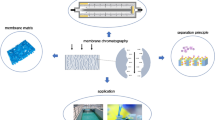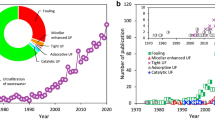Abstract
The usage of ionic polysulfone (PSF) hollow fiber for the ultrafiltration of protein was investigated. The surface of polysulfone hollow fiber was sulfonated through the Blanc chloromethylation reaction to become anionic. Characterization of the modified hollow fiber was performed including ion exchange titration, pure water permeation, and molecular sieving measurement. The performance of ultrafiltration of protein was evaluated using myoglobin at various pH values. The results show that the water contact angles and hydraulic resistance are markedly decreased, indicating that the surface-modified PSF hollow fibers are more hydrophilic. In addition, the retention of myoglobin depends on the pH of the solution. At a pH higher than the isoelectric point of myoglobin, both hollow fiber and the protein have the same charge sign, and both the flux of the solution and the retention are the highest. The sulfonated PSF hollow fiber may be used as a biomaterial for protein separation and purification.
Similar content being viewed by others
References
J.-F. P. Hamel, J. B. Hunter and S. K. Sikdar, Downstream processing and bioseparation: Recovery and purification of biological products, in ACS Symposium Series 419, American Chemical Society, Washington, DC, 1990.
J. A. Howell and M. Nyström, Fouling phenomena, in Membranes in Bioprocessing: Theory and Applications, J. A. Howell, V. Sanchez and R. W. Field (eds), Blackie Academic & Professional, London, 1993, Ch. 6.
I. Cabasso, E. Klein and J. K. Smith, Polysulfone hollow fibers. I. Spinning properties, J. Appl. Polym. Sci., 20, 2377-2394 (1976).
I. Cabasso, E. Klein and J. K. Smith, Polysulfone hollow fibers. II. Morphology, J. Appl. Polym. Sci., 21, 165-180 (1977).
I. Cabasso, K. Q. Robert, E. Klein and J. K. Smith, Porosity and pore size determination in polysulfone hollow fibers, J. Appl. Polym. Sci., 21, 1883-1900 (1977).
T. Liu, D. Zhang, S. Xu and S. Sourirajan, Solution-spun hollow fiber polysulfone and polyethersulfone ultrafiltration membranes, Separation Science and Technology, 27, 161-172 (1992).
Y. Nagase, A. Naruse and K. Matsui, Chemical modification of polysulphone: 1. Synthesis of polysulphone/polydimethylsiloxane graft copolymer, Polymer, 30, 1931-1937 (1989).
Y. Nagase, A. Naruse and K. Matsui, Chemical modification of polysulphone: 2. Gas and liquid permeability of polysulphone/polydimethylsiloxane graft copolymer membranes, Polymer, 31, 121-125 (1990).
J. Sheldon, The fine-structure of ultrafiltration membranes. I. Clean membranes, J. Membrane Sci., 62, 75-86 (1991).
J. M. Sheldon, I. M. Reed and C. R. Hawes, The fine-structure of ultrafiltration membranes. II. Protein fouled membranes, J. Membrane Sci., 62, 87-102 (1992).
J. D. Le Roux and D. R. Paul, Preparation of composite membranes by spin coating process, J. Membrane Sci., 74, 233-252 (1992).
E. Hinke and E. Staude, Streaming potential of microporous membranes made from homogeneously functionized polysulfone, J. Appl. Polym. Sci., 42, 2951-2958 (1991).
A. Higuchi, N. Iwata, M. Tsubaki and T. Nakagawa, Surface-modified polysulfone hollow fibers, J. Appl. Polym. Sci., 36, 1753-1767 (1988).
A. Higuchi, N. Iwata and T. Nakagawa, Surface-modified polysulfone hollow fibers. II. Fibers having CH2CH2CH2SO 3- segments and immersed in HCl solution, J. Appl. Polym. Sci., 40, 709-717 (1990).
A. Higuchi and T. Nakagawa, Surface-modified polysulfone hollow fibers. II. Fibers having a hydroxide group, J. Appl. Polym. Sci., 36, 1973-1979 (1988).
A. Higuchi, S. Mishima and T. Nakagawa, Separation of proteins by surface modified polysulfone membranes, J. Membrane Sci., 57, 175-185 (1991).
S. Nakao, H. Osada, H. Kurata, T. Tsuru and S. Kimura, Separation of proteins by charged ultrafiltration membranes, Desalination, 70, 191-205 (1988).
W. H. Daly, Modification of condensation polymers, J. Macromol. Sci., Chem., A22, 713-728 (1985).
C. Luca, S. Dragan, V. Barboiu and M. Dima, Chlorometylated polystyrene reaction with tris(2-hydroxyethyl)amine. I. Crosslinked polymers prepared by chloromethylated polystyrene with tris(2-hydroxyethyl)amine, J. Polym. Sci.: Polym. Chem. Ed., 18, 449-454 (1980).
H. Miyama, N. Marumiya, Y. Mori and H. Tanzawa, A new antithrombogenic heparinized polymer, J. Biomed. Mater. Res., 11, 251-265 (1977).
P. Zschocke and D. Quellmalz, Novel ion exchange membranes based on an aromatic polyethersulfone, J. Membrane Sci., 22, 325-332 (1985).
A. I. Vogel, Vogel's Textbook of Practical Organic Chemistry, 4th Edit., Longman, London, 1978, p. 636.
UDEL Polysulfone Design Engineering Data, Amoco Performance Products Inc., Section 1, 2.
H. Miyama, K. Tanaka, Y. Nosaka, N. Fujii, H. Tanzawa and S. Nagaoka, Charged ultrafiltration membranes for permeation of proteins, J. Appl. Polym. Sci., 36, 925-933 (1988).
A. Suki, A. G. Fane and C. J. D. Fell, Flux decline in protein ultrafiltration, J. Membrane Sci., 21, 269-283 (1984).
K. J. Kim, A. G. Fane, R. Ben Aim, M. G. Liu, G. Jonsson, I. C. Tessaro, A. P. Broek and D. Bargeman, A comparative study of techniques used for porous membrane characterization: Pore characterization, J. Membrane Sci., 87, 35-46 (1994).
Author information
Authors and Affiliations
Rights and permissions
About this article
Cite this article
Yang, MC., Lin, WC. Ultrafiltration of Myoglobin using Surface-Sulfonated Polysulfone Hollow Fiber. Journal of Polymer Research 9, 61–67 (2002). https://doi.org/10.1023/A:1020610919593
Issue Date:
DOI: https://doi.org/10.1023/A:1020610919593




